Professor Robert Wade travelled to Istanbul in late July 2017 to take part in the annual cross-continental 6.5 km swim “race” along the Bosphorus. Here he describes his experience as a participant in the race, as well as his time in a country that is going through great political change.
I am hardly a long-distance swimmer, but I have been inspired by the story of Lord Byron, icon of the free swimming community, who swam “several miles” from Europe to Asia across the Dardanelles in 1810. The Dardanelles is a straight similar to the Bosphorus but south of the Sea of Marmara; it was called Hellespont in Classical Antiquity. Byron described his swim as the feat more meaningful than anything else he’d achieved, whether “political, poetical or rhetorical”.
Here is a short account of the Bosphorus swim, with its choppy seas and dangerous currents, followed by an account of the choppy seas and dangerous currents of the current Turkish political situation as I encountered it talking to Turkish academics. First some background.
The annual cross-continental “race” from Asia to Europe is organized by Municipality of Istanbul and Turkish Olympic Committee, sponsored by Samsung.[1] The race morning is the one time of the year that the Bosphorus is regularly closed to what is otherwise a Piccadilly Circus-like procession of ships big and small in both directions. 2017 was the 29th year. The swim starts a kilometer north of the Second Bridge (of three Bosphorus bridges), and ends about a kilometer north of the First Bridge (now called the July 15 Bridge, in memory of those who died on the bridge in the attempted “coup d’etat” on that day in 2016). The direction is north to south, the direction of the main Bosphorus current. If you judge the course correctly, the distance is 6.5 kms. If you don’t …
The Bosphorus is not a place for normal swimming, because of its dangerous currents. In the rare places where the public has access to the shore, there are no beaches; the pedestrian area ends with a drop of a meter or two to the water and steps are few and far between, the point being to discourage swimming. Too bad if you fall in.

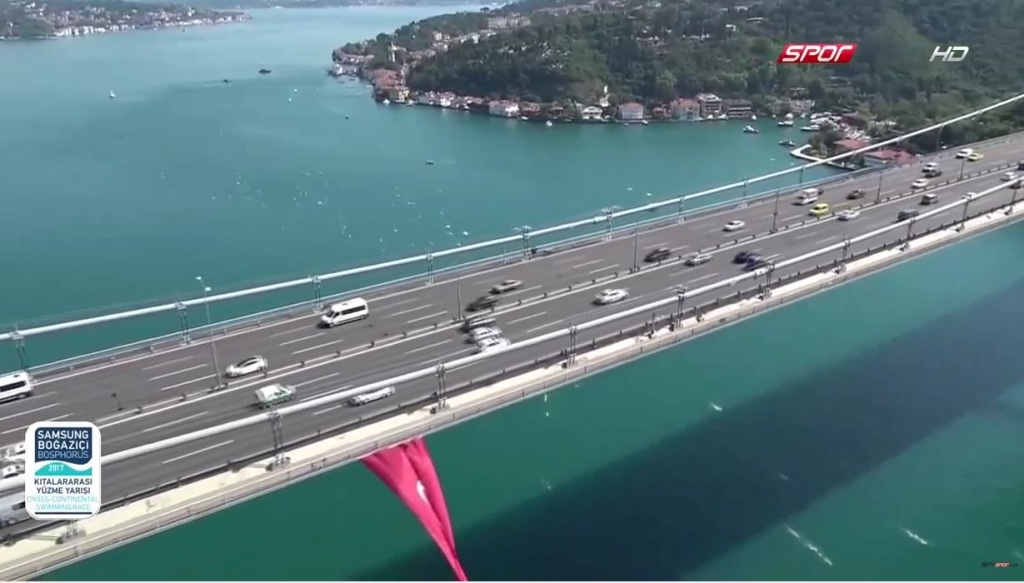
This year, Sunday 23 July, 2,200 swimmers started, including 1,000 “foreign” swimmers (this is their quota). You have to apply to be selected; and the organizers publish the list of accepted swimmers as late as early July for the swim in late July!
The website for applications opens early January. By the time I realized it was open the website said that the quota for foreign swimmers’ applications was filled within 16 minutes of opening – so no more applications accepted.
By a circuitous route I did manage to obtain an application form, filled it in (including a doctor’s statement of physical condition and a swim coach’s statement of my ability to complete the course), and sent it off. Months later I was informed that my application had been received (not the same as being accepted).
Swimmers register on the Friday or Saturday and receive a backpack with the all-important chip and numbered swimming bonnet inside. They go on a boat trip up to the start, and on the return journey the race organizers shout out guidance for the race in three languages, Turkish, English, Russian.
On Sunday morning, swimmers board the boat to the start two by two, reminiscent of Noah’s Ark. The boarding is protracted, and once on board, swimmers stand packed tight as sardines. I began to think, “This is not such a good idea afterall”, and wished that time could run backwards.
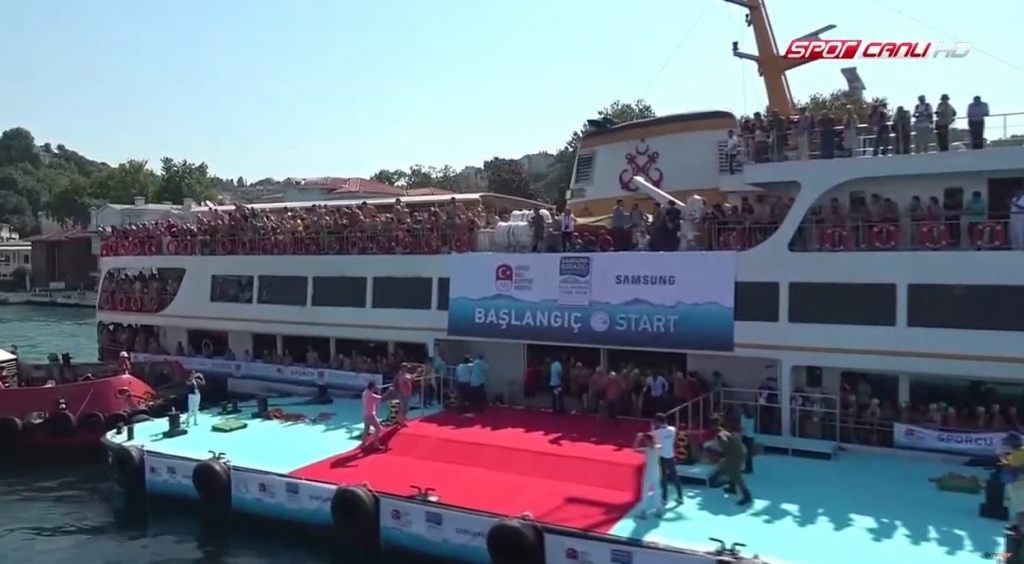
Water temperature was 22 C, a bit cooler than usual. The reason was that Istanbul had had torrential rain a few days before. Nobody mentioned that for the same reason the currents would be extra strong and tricky.
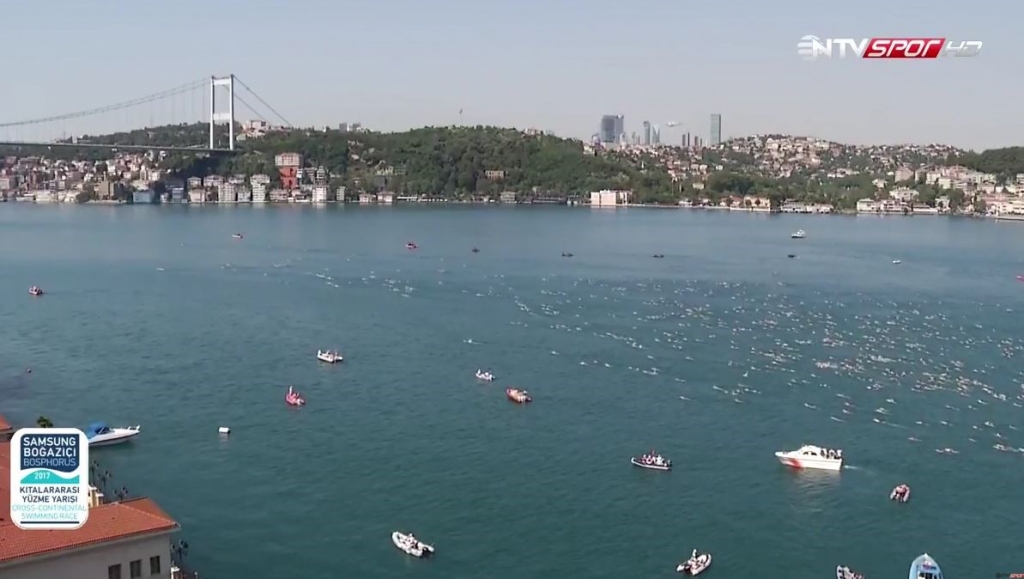
Once in the water I headed in a straight line (so I thought) for the mid-point of Second Bridge. The water was luminous in the sunshine, and not too cold. I was surprised and glad not to be thrashing in a crowd of other swimmers – I was swimming fairly much on my own. I should have realized what this meant. Most of the others had taken a line not straight for midpoint, but straighter into mid-stream from the take-off, because of the current. By the time I crossed under Second Bridge I was already swept by the current (of which I was unaware) too close to the Asian side, too far from the bridge midpoint.
Much later, I knew something was very wrong when a “rescue boat” circled me, siren blaring, and people on board shouted “right, right”, meaning I had to change direction and swim hard right to reach the finish point. But by this time I was also on wrong (Asian) side of the Bosphorus, so the finish point was far to the other side. I could not distinguish the finish point from all the other constructions in the distance. Then began a mighty struggle against the distance, the currents and the choppy seas.
I saw the looming hulk of the First Bridge in the distance to my left. I swam hard, breathing only on the right – and therefore not noticing what was happening on the left. After a while, the water instantly turned from luminous sunshine to black. I startled, looked up, and saw to my horror that I was in the shadow of the First Bridge directly overhead – which meant I was a good kilometer past the finish point. I redoubled my efforts to regain the sunshine and move upstream. But the water suddenly turned black again and I saw the bridge above me for the second time, like a Monster. I redoubled my efforts and regained the sunshine, but the Monster struck again. In my mind’s eye I saw the map of the Mediterranean. If I got swept below the First Bridge there wasn’t much to stop me going all the way to Egypt! I had been told at the start there would be a line of rescue boats at the First Bridge, but I didn’t see sign of them.
To cut a long story short, I headed directly to the European shore, then inched my way up the shore against a fierce current until, finally, the finish point.
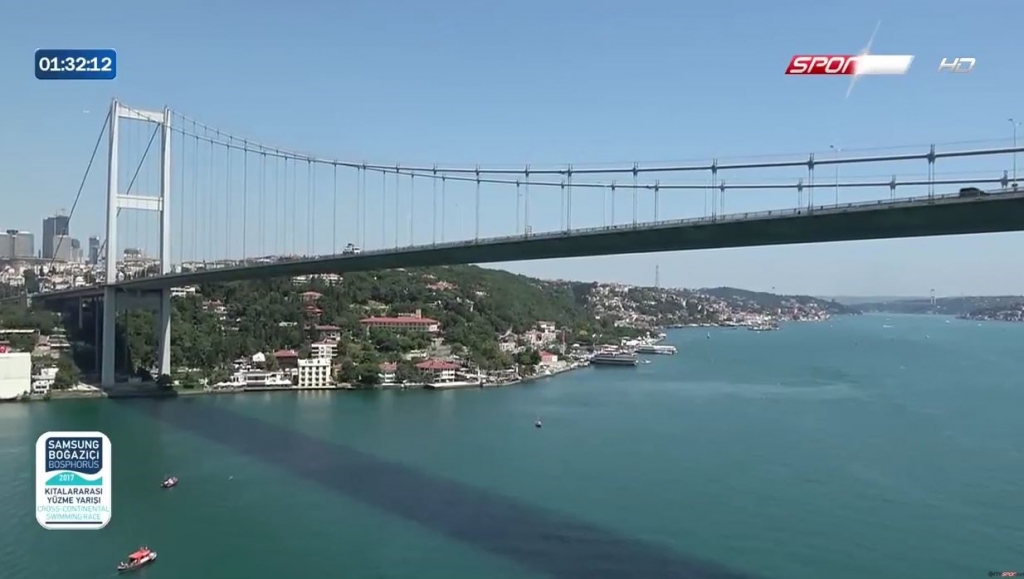
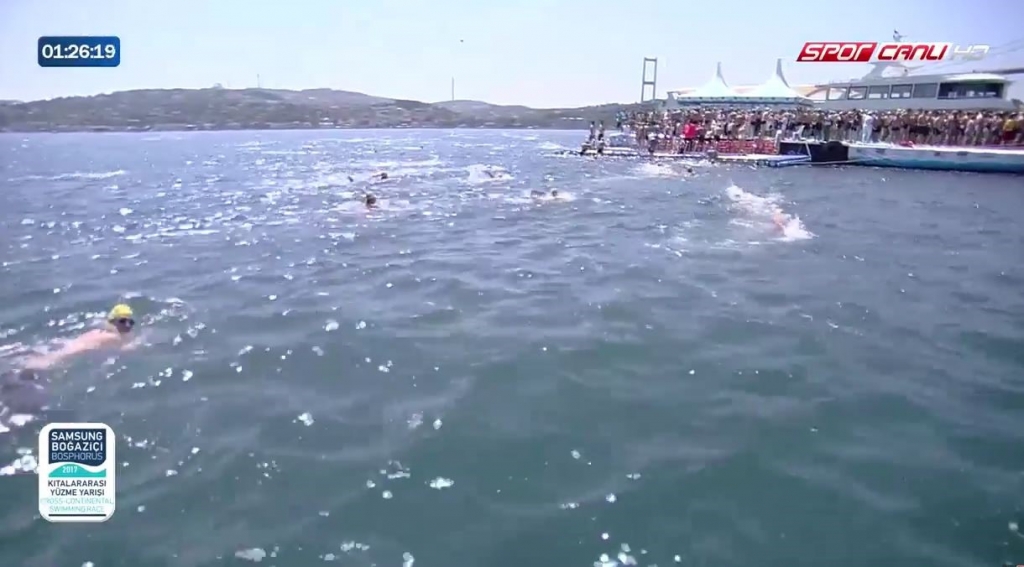
A friend who had also swum confessed that of her 14 swims, this year was the most difficult. She too misjudged the currents and found it hard to pick out the landmarks, and had been swept below the finish point (but not nearly as far down as First Bridge), then had to fight her way back upstream. Those heavy rains in the preceding days had made the currents very different from “normal”.
A Russian male swimmer in the 25 – 29 years category swam the fastest time, 51 minutes, which translates to 8 minutes a kilometer. “Prodigious”, is the only word. He must have been surfing, like the America’s Cup yachts up on hydrofoils. A Turkish woman in the same age category had the fastest female time, 1 hour.[2]
My time was 1 hour and 59 minutes – but I covered about 9 kilometers, which translates to 13 minutes per kilometer. This is faster than I can swim in still water, and more testimony to strength of the current.
Armed with this new knowledge, I intend to do it again — assuming that Turkey does not explode. The failed coup on 15 July 2016 prompted the government of President Erdogan to tighten its grip on the country in the form of “a state of emergency”, still in force. Some 150,000 people have been fired or suspended – politicians, civil servants, writers, journalists, academics, other professionals; and another 50,000 have been arrested. 38,000 inmates convicted of fraud, rape, theft, looting, and extortion were released before completing their sentences to make room for the avalanche of newcomers. The criminal evidence against one columnist included the sentence in a Tweet, “Edison wouldn’t have invented the ‘light bulb’ if he saw these days”. The electoral symbol of Erdogan’s AKP party is a light bulb. The court ordered his release on his hearing in March. The judges in his case were removed from office the same day. As he prepared for release from prison, he was rearrested. He remains in one of Turkey’s abysmal jails, awaiting his next trial.[4]
I spoke on Monday to some academics at Istanbul University. The university was established in 1453, the year the Ottomans conquered Constantinople. It is located in the middle of Old Istanbul, close by the famous mosques. The main complex has a bucolic campus, with lush green lawns and sculpted trees, while just meters away outside the walls Istanbul bustles on. The campus looks to be the perfect place for contemplation and research (especially when, as now during summer break, there are no students about). When Hitler swept to power in Germany, many German professors took refuge on the faculty of this university. Earlier, a young physicist named Albert Einstein applied for a job, and was rejected.
Bucolic though the campus is, many academics are suffused with anxiety and fear. I spoke to a few one on one (not in groups). They dare not talk about the political situation amongst themselves, not even with colleagues they have lunched with for years. They dare not use words like “democracy”, “liberalism”, “human rights” in conversation or lectures, or criticize the government (except when alone with foreigners). The official story of the attempted coup is that it was mounted by “Gulenists” (followers of Turkish preacher Fethullah Gulen, leader of a transnational religious and social movement, who has lived in the US since 1999) against the Erdogan state. The standard charge against a critic of the government is: “you are or might be a Gulenist and therefore an enemy of the state.” Economists teach economics as though a branch of engineering.
One academic has dismayed some of his friends by declaring, on Twitter, his fealty to fundamentalist (non-violent) Islam – including denouncing Darwinism and using swear words to describe people who believe in evolution of species. Whether or not the person believes it, it is a good survival strategy.
One of the professors has languished in jail for the past eight months. He was a newspaper columnist as well as academic, and before arrest wrote several columns criticizing the government for administrative inefficiency, failing to improve infant mortality and reduce unemployment, and invoked words like “democracy”, “liberalism”, and “human rights”. It is thought that these columns prompted the government to jail him, as a signal to others. “It is thought”, but after eight months, no charges have been brought. Is the university fighting for his justice? The head of department is married to one of the few prominent women legislators in Erdogan’s AKP party. Decent man though he is, he is not putting his marriage at risk, I was told. The vice dean of the faculty is an early 30s rising star in the AKP.
A famous doctor in the university’s Medical School was fired, his passport removed, his wife fired from her job, her passport removed, he sought employment in a private hospital (to work inconspicuously at night), the government told the private hospital that if it employed him the government would shutter the hospital. Some 20 German journalists and civil society personnel have been jailed.
This is 1930s lite. To understand the government’s playbook, we should re-read The Klemperer Diaries. Especially because it seems that the attempted coup was not quite what it seems. But rather than continue to talk about politics and repression, it is safer to go swimming — even in the Bosphorus.
[1] http://bogazici.olimpiyatkomitesi.org.tr/. I am grateful to Petra Sonnenberg for helped in the preparation of this account.
[2] Results: http://bogazici.olimpiyatkomitesi.org.tr/Upload/Sonuclar/2017_Categories.pdf
[4] Patrick Kingsley, 2017, “Mysteries remain after Turkey’s failed coup”, New York Times (International), 15-16 July. Safak Pavey, 2017, “Inside Erdogan’s prisons”, New York Times (International), 15-16 July.






Robert H. Wade is Professor of Political Economy at the London School of Economics
The views expressed in this post are those of the author and in no way reflect those of the International Development LSE blog or the London School of Economics and Political Science.